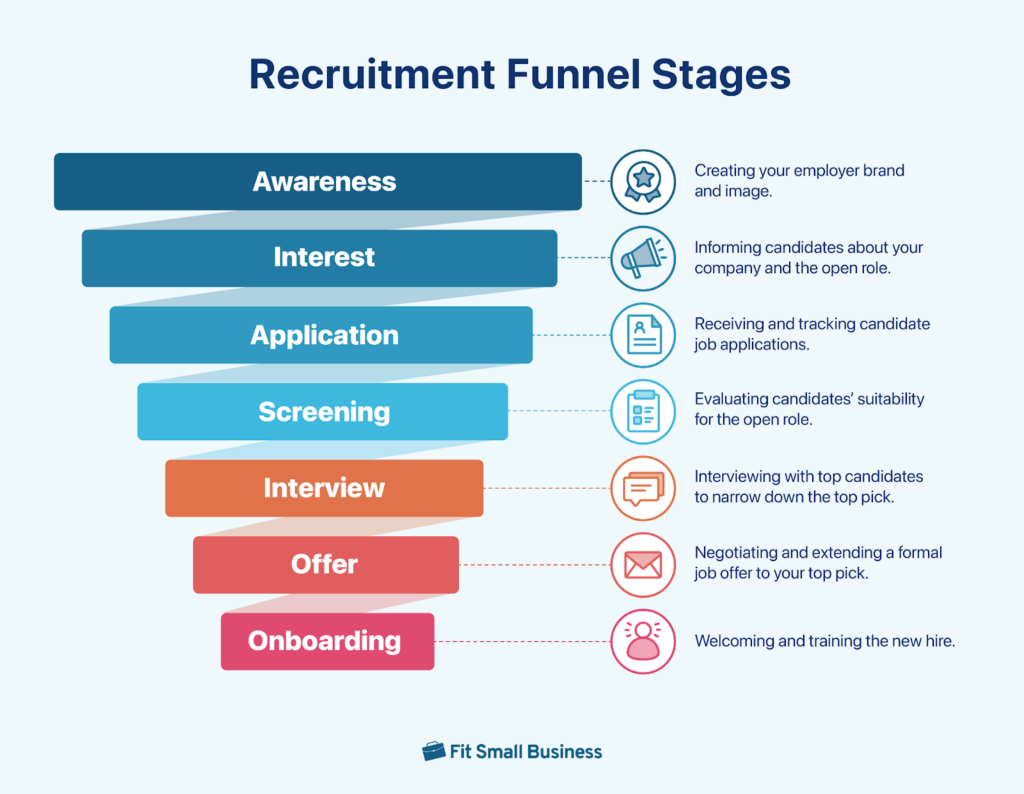Key Takeaways:
- A recruitment funnel is a systematic process to attract, evaluate, and hire top talent.
- Optimizing each stage of the recruitment funnel lets you attract high-quality candidates.
- Regularly track key recruiting funnel metrics to find bottlenecks and areas for improvement.
What Is a Recruitment Funnel?
A recruitment funnel is a structured process that guides candidates through seven stages, from awareness to hiring. This funnel begins by attracting potential candidates and narrows down to selecting the most suitable ones for the job. The recruitment funnel works by filtering out unqualified candidates at each stage, ensuring that only the best move forward.

Paying attention to it allows you to systematically manage and streamline your recruiting efforts, saving time and resources. By clearly defining each stage, you can identify where candidates drop off and make necessary adjustments to improve your funnel. This method not only enhances efficiency but also helps in attracting high-quality candidates, ultimately leading to better hires.
Recruitment Funnel Stages & How to Optimize (+ Examples)
Each stage of the recruitment funnel serves a distinct purpose in narrowing down candidates and ensuring the best fit for your organization. Below is each stage in detail, with some tips on how to optimize them for better results. We also provide an example for each stage using the fictional company “GreenLeaf Marketing”—a boutique digital marketing agency that needs an administrative assistant—to see how each stage works in practice.
The first stage in the recruitment funnel is awareness. At this stage, potential candidates learn about your company and job openings. This can happen through various channels, such as job boards, social media, and your company’s website.
To optimize this stage, ensure your job ads are clear, engaging, and include relevant keywords. On top of that, you have to focus on your employer branding and let potential applicants fully understand what your workplace is about. Use social media to showcase your company culture and attract passive candidates. Highlight your company’s values and work environment to make a strong first impression.
Example
GreenLeaf Marketing’s HR team posts the job opening on various job boards, like Indeed and LinkedIn, and on their company website. They also share the job posts across their social media platforms, including LinkedIn, Facebook, and Twitter, and send their ads to local universities and professional networks. By doing this, GreenLeaf Marketing attracts a wide pool of potential candidates who now know about the opportunity.
Once candidates are aware of your job openings, the next stage is to generate interest. Here, candidates consider whether they are interested in the position and the company. Providing detailed job descriptions, company information, and employee testimonials can help.
To optimize, make sure your careers page is informative and easy to navigate. Engage with candidates through personalized email campaigns and respond promptly to inquiries. Consider creating engaging content like blog posts or videos that give a behind-the-scenes look at your company.
Example
GreenLeaf Marketing’s recruitment team creates the position’s job description, detailing the role’s responsibilities and highlighting the company culture, emphasizing its supportive and collaborative work environment. Employee testimonials and a short video showcasing a day in the life at GreenLeaf Marketing are also included to engage potential candidates and encourage them to consider applying.
The application stage is where interested candidates submit their applications. This stage should be as straightforward as possible to avoid losing potential talent. Use an applicant tracking system (ATS) to streamline the application process.
Optimize by keeping the application form short and only asking for essential information. Offer candidates the option to apply using their LinkedIn profiles to save time. Ensure the application process is mobile-friendly to accommodate candidates applying from different devices.
Example
Interested candidates submit their resumes and cover letters through GreenLeaf Marketing’s ATS. To streamline this process, the application form is kept concise, only requesting essential information such as contact details, work experience, and a brief cover letter. Candidates are also given the option to apply using their LinkedIn profiles to save time and increase the likelihood of completed applications.
After receiving applications, the screening stage begins. This is where you assess candidates’ qualifications and suitability for the role. Initial screening can be done through resume reviews, phone interviews, or pre-employment tests.
To optimize this stage, use automated tools to scan resumes for keywords and qualifications, making sure you stay compliant and are giving every applicant a fair chance. Develop a consistent screening process to ensure fairness and efficiency. Consider using pre-screening questionnaires to filter out unqualified candidates early.
Examples
Besides resume screening, GreenLeaf Marketing’s HR team leverages automated tools to scan for keywords and qualifications relevant to the administrative assistant role, such as experience with office software, organizational skills, and prior administrative experience. Initial phone screenings are conducted to further assess candidates’ suitability, focusing on their communication skills and availability.
The interview stage is crucial for evaluating a candidate’s fit within your company. This can include phone interviews, video interviews, and in-person interviews. We recommend a structured interview process to assess each candidate fairly.
Optimize by training your interviewers on best practices and ensuring they provide a positive candidate experience. Use structured interviews to reduce hiring bias and compare candidates effectively. Ensure interviewers are well-prepared and have reviewed the candidate’s resume and screening notes.
Example
GreenLeaf Marketing’s hiring team prepares a set of standardized questions to ensure consistency and fairness in evaluating each candidate. During the interviews, the interviewers assess candidates’ skills, experience, and cultural fit, looking for attributes like attention to detail, reliability, and the ability to work well in a team. Once done, interviewers fill out scorecards, provide feedback, and then the company’s hiring managers review each candidate collectively to decide which ones move forward.
Once you’ve identified the right candidate, it’s time to make an offer. This stage involves negotiating salary, benefits, and other terms of employment.
To optimize, be transparent about compensation and benefits from the beginning. Use market data to ensure your offer is competitive. Communicate clearly and promptly to avoid losing top talent to other opportunities. Provide a detailed offer letter that outlines all aspects of the job and benefits.
Example
After GreenLeaf Marketing’s executive team decides on a candidate, they work out the offer details with the HR team. They use market data to ensure the offer is competitive. The HR team then discusses the salary, benefits, and other terms of employment with the candidate. The offer letter is detailed, outlining all aspects of the job and benefits, ensuring the candidate has all the necessary information before their first day.
The final stage is onboarding, where the candidate transitions to an employee. A smooth onboarding process is critical for new hires to feel welcomed and prepared. Provide a comprehensive onboarding plan that includes training, introductions to team members, and access to necessary resources.
To optimize, use onboarding software to track progress and ensure all tasks are completed. Regular check-ins during the first few months can help address any concerns and improve retention. Create a welcoming environment by providing a buddy system or mentorship program for new hires.
Example
GreenLeaf Marketing provides a comprehensive onboarding plan, which includes training sessions, introductions to team members, and access to necessary resources, like office software and tools. The new hire is paired with a mentor to help them settle into their role and understand company processes.
Recruitment Funnel Metrics to Track
Certain quantitative metrics track the efficiency and effectiveness of your recruitment funnel. By analyzing the data, you can pinpoint bottlenecks, improve candidate experience, and ultimately make better hires. Here are the key metrics you should track:
1. Conversion rates: Conversion rates measure the percentage of candidates who move from one stage of the recruitment funnel to the next. High conversion rates indicate a well-functioning process, while low rates suggest potential issues.
To optimize this, identify where candidates drop off and make necessary adjustments. For instance, if many candidates leave at the interview stage, consider improving your interview process or interviewer training.
2. Time to fill: Time to fill measures the average number of days to fill a position, from the job posting to the new hire’s start date. It helps you understand how quickly you can attract and hire qualified candidates. Generally, this takes 30 to 45 days—though this will vary depending on the industry and position being filled.
To improve your time to fill, streamline your processes. Utilize technology, like applicant tracking systems and AI, to automate parts of the process and reduce delays. This can lead to higher satisfaction for both candidates and hiring managers.
3. Cost per hire: Cost per hire calculates the total cost of hiring a new employee, which includes advertising expenses, recruiter salaries, and any other related costs. A good baseline is to budget about $5,000 for this—but be aware this amount can vary widely based on your industry and the position you need to fill.
To ensure a good cost per hire, track all expenses and identify areas where you can reduce costs without compromising quality.
4. Candidate quality: Candidate quality assesses the overall suitability of candidates who are eventually hired and is measured through post-hire evaluations, performance metrics, and retention rates. High candidate quality leads to better performance and higher retention rates, making your recruitment process more successful in the long run.
For the best candidate quality, focus on improving the screening and interview stages to ensure you are selecting the best candidates.
Recruitment Funnel Frequently Asked Questions (FAQs)
A recruitment funnel is a structured process that guides candidates through various stages, from awareness to hiring. It helps streamline and organize the recruitment process, ensuring that only the best candidates move forward at each stage. This method improves efficiency and effectiveness in hiring.
The recruiting funnel ratio typically refers to the conversion rates between stages. For instance, you might aim for a ratio where 20% of applicants move to the screening stage, 50% of those screened proceed to interviews, and 10% of interviewees receive offers. These ratios can vary based on industry, role, and recruitment strategies.
To create a recruitment funnel template, outline each stage of the process: Awareness, Interest, Application, Screening, Interview, Offer, and Onboarding. Define key actions and metrics for each stage. Use tools like spreadsheets or applicant tracking systems to manage and track progress through your recruiting funnel.
A recruitment funnel helps you systematically manage your hiring process, leading to more efficient and effective recruitment. It allows you to track and optimize each stage, ensuring you attract and retain top talent. It provides valuable insights through recruiting funnel metrics, helping you make data-driven decisions.
To optimize a recruitment funnel, focus on attracting quality applicants through targeted outreach and engaging content. Ensure the application process is straightforward and user-friendly. Track metrics like conversion rates and time to fill to identify areas for improvement and streamline your admissions process.
Bottom Line
A well-optimized recruitment funnel is essential for attracting and hiring top talent. By understanding what a recruitment funnel is and applying key metrics, you can streamline your hiring process and make data-driven decisions. Regularly reviewing and refining your recruitment funnel ensures you stay competitive and continuously improve your recruitment outcomes.
Implementing a recruiting funnel takes time and effort, but the benefits are well worth it. Use the strategies and examples provided to build and optimize your own recruitment funnel. Keep adapting and improving your approach to meet the evolving needs of your organization and the job market. By doing so, you’ll create a robust system that consistently delivers high-quality hires.


